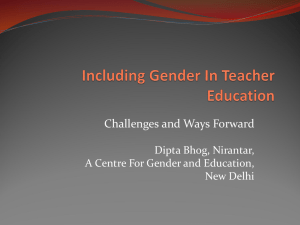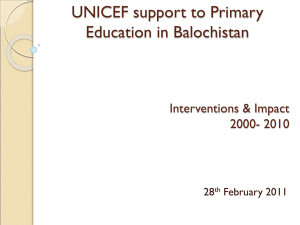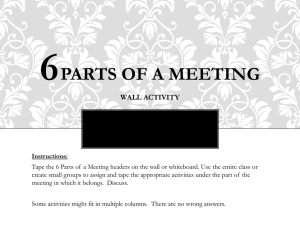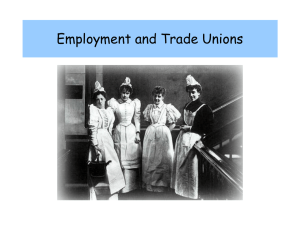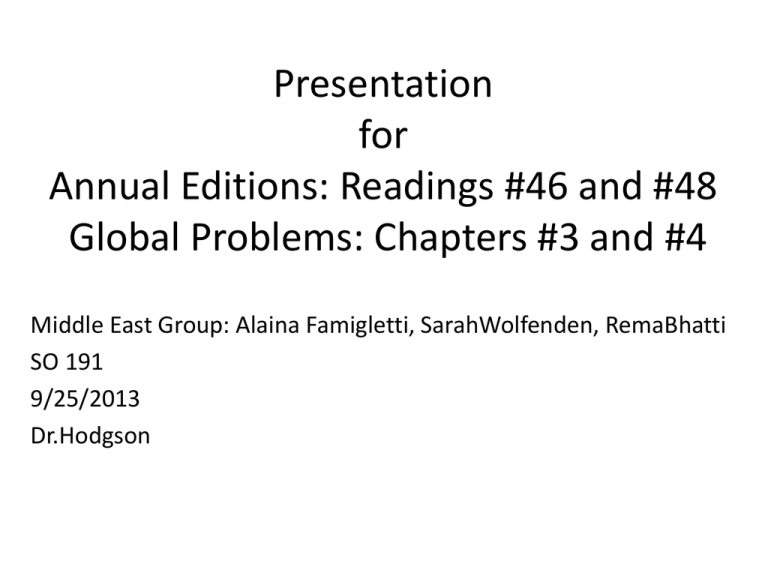
Presentation
for
Annual Editions: Readings #46 and #48
Global Problems: Chapters #3 and #4
Middle East Group: Alaina Famigletti, SarahWolfenden, RemaBhatti
SO 191
9/25/2013
Dr.Hodgson
Annual Editions #46
The Women’s Crusade by Nicholas D.
Kristof and Sheryl WuDunn
Question 1:
What is the overarching theme of this
passage and how did you find the
tone of the writers? Do you think
their suggestions are realistic?
Question 1
• The overarching theme is that providing aid to countries specifically
to empower and educate women will help make the gender playing
field more level for women in developing countries. Personally, I
found the tone to be fanatic. The writers only provided anomalous
examples of successful women and didn’t illustrate the daily reality
for women who are not progressing. I think their suggestions are
unrealistic because they are telling us success stories which make us
less likely to want to participate because we figure that somehow
gender equality will just become achievable on its own. The two
stories about Saima learning how to start an embroidery business
and Tererai pursuing her Ph.D are beautiful, but do they really show
what the main issues are? Also I think the writers illustrate the
solution to be people with money giving it to people in developing
countries rather than people going in to help or actually teaching
women how to empower each other. I think that their ideas are great
but ultimately too idealistic. How can we realistically help these
women if we aren’t exposed to the truth.
Question 2:
“But even so, the economist Esther Duflo of M.I.T found
that when men’s crops flourish, the household spends
more money on alcohol and tobacco. When the women
have a good crop, the households spend more money on
food. ‘When women command greater power, child health
and nutrition improves’ Duflo says (203).”
What do you think of this statement? Are there other
possible impacts on what households spend money on?
Question 2
• Personally I think this statement is a distortion of perceived aims at
gender equality. The date provided is strictly correlative which
essentially does not prove anything. I think that there must be other
factors going into what households spend money on, for example,
cultural habits, gender role perception, etc. It is one thing to want to
say yay let’s give more power to women, but in some of these places
the culture doesn’t allow room for this to happen so I think that other
cultures need to be regarded too. Obviously I come from a
euroamerican world view and believe that women should have more
power and would help with practical spending but this doesn’t mean
that this can just happen because I want it to. I think this needs more
research on how to effectively instate these goals rather than just
saying yay let’s make them happen!
Question 3:
“98% of people in Egypt say they believe that
‘girls have the same right to educations as
boys (203).”
What is wrong with this statement?
Question 3
• It assumes that boys have the ultimate right to
education and that girls, a deviation from the ideal
human, happen to have the same rights too. I think it
should say girls and boys have the same right to
education. I think this idea of girls being “just as good
as” boys is reiterated throughout the article and
exemplifies the persistence of gender inequality in
western society today. Ultimately, while the article
makes a nice attempt to advocate and empower
women, it still has a long way to go in making clear it’s
ideology.
Annual Edition #48
Girls in War by Radhika
Coomaraswamy
Question 1:
What do you think about the
“vulnerability of girls in armed conflict?”
How does this article contextualize the
previous article?
Question 1
• The lens that Coomaraswamy uses to look at violence against
women in developing countries is interesting because it is a
military action context. Thus she illustrates how many of the
problems that were highlighted in the previous article occur
as a result of war and civil unrest rather than just as culturally
embedded practices. I think this article provides a more
realistic basis to work with because we see why this is
happening to young women and girls across the globe and
that the problem is much more complex than just something
we can “send aid to.”
Question 2:
“At the international level commentators have always
pointed to “waves” of trafficking...These waves often
occur in ares of armed conflicts; women flee in large
numbers, and being sex workers is their only survival
strategy (212).” What are some examples of human
trafficking you have heard of? This is becoming an
increasing problem that is linked to globalization, why
is this happening more often?
Question 3:
“I was in the Central African Republic and met three
generations of women in one family who had been raped
when Jean-Pierre Bemba’s troops attacked the capital,
Bangui. They were getting ready to go to the Hague and
testify against him. Their elation at the possibility of justice
and their gratitude that these things have come to pass has
convinced me that we are on the right path (213).”
How do you feel about this conclusion?
Question 3
• I think it suggests realistic progress. The fact
that these women who have been treated so
violently are finally getting a voice will really
make a difference. It is a small step but
eventually all of these small steps will
hopefully create a true change over time.
Global Problems: Chapter 3
Gender and Family: Overburdened
Women and Displaced Men
Questions
1.) How have the roles of men and women
changed? What is meant by “tired, stressed
women and angry alienated men?” Do you think
it is possible to ease the burden felt by both
genders?
2.) How have these changes in roles of men and
women effected child-rearing and marriage?
3.) What is meant by the “feminization of
migration?” What are some challenges still faced
by women worldwide today?
Question 1:
• Women work “second shift” and often feel angry and
frustrated that they still do the major portion of housework
on top of having a job.
• Jobs that use to require strong men have been replaced by
automation and mechanization, which leaves men feeling
disgraced and alienated as they fail to provide for their
families (women become even more over-burdened.)
• It is not easy for men to step into traditional female roles of
domestic tasks and child care.
• Women feel “locked in” to the demands of the home and
job, and Men feel “locked out” of the labor market and of
their families.
• Middle and upper-middle class men feel “the time bind” as
they are expected to be devoted to their careers and more
involved in parenting.
Question 2:
• Europe provides generous maternity leave followed by
subsidized childcare. (France- “écoles maternelles”)
• China, India, and U.S. the caregiver is often a grandmother or
older family member
• People are marrying later and divorcing more often—
marriage is about romance and companionship, which makes
it more optional
• World divorce rates continue to rise with the U.S. being the
highest in the industrial world (low rates in Catholic countries
like Ireland, Italy and Poland as well as in N. Europe where
people are slower to marry)
• Lowest divorce rate in industrial world is Japan due to stigma
against divorced couple and lower expectations of marriage
• Semi-arranged marriages in India are enduring
Question 3:
• Trafficking of women and girls from Albania and
eastern Europe
• Wealthier countries have been flooded with
female domestic workers—they also work on
cruise ships and in overseas resorts
• Women work in independent sales (Brazil has
more Avon beauty consultants than it has
soldiers)
• Women still earn less than men and are
underrepresented in top government and
corporate positions
Global Problems: Chapter 4
Education
Access and Success
Question 1:
Through out the world if a college education is
possible is it even worth it? Should college be seen as
an investment? What are your thoughts on how one
should get into college?
Question 1:
• In some countries, students are unable to find jobs after they
graduate.
– Countries aren’t stable enough to provide a strong work force. i.e.
Mauwi Funidi of Kisangani, Congo is a librarian but is struggling
because the nation is torn by civil war, the library does not
purchase more books, the books are never used because the
university classes hardly meet.
– India sends the graduates abroad to find jobs
– In the United States there is a stress on whether or not students
are ready to work after college.
• Students are paying for college by looking at it as an investment but
sometimes they are not getting back the return.
• Should there be competitive standardized tests like Japan to get into
college or should everyone get a chance at college or more be a
method like in Germany
Question 2:
Around the world what was a common
theme seen in the education system;
in terms of how countries often find a
division?
• Social Class
Question 2:
– In many countries children in the working class or poor
areas are not able to afford the education. Parents of
these children also send them to work at young ages to
provide income in the house.
– Even if the child gets to college in some countries it is
hard for them to stay such as Mexico , although tuition
is free living expenses are costly.
– Kozol wrote in the Savage Inequalities(1991) states
that there is still a racial segregation in the public
schools by divided communities due to the fact that
schools spend from what local property taxes are
generated.
Question 3:
What are the four main practices of education? In
your opinion which is the most important to follow
in education and why? How do you think it is
possible to use these as a foundation for an
education system?
Question 3
• Inclusive Education:
– Every child regardless of gender, region, or race/ethnicity must be
given a chance at education. A child can not learn until the parent is
also educated.
• Equal Education:
– Quality education for girls (this has been a prominent issue through
out the world. Girls are seen less likely to need an education thus are
not granted one)
– Societies with notable differences: some neighborhoods lack
resources (rich and poor)
• Practical Education:
– Education must include useful skills in communication, analysis, and
problem solving and working with complex systems and technology.
• Liberal Education:
– Students are learning to be citizens along with workers. Effective
education should open minds





